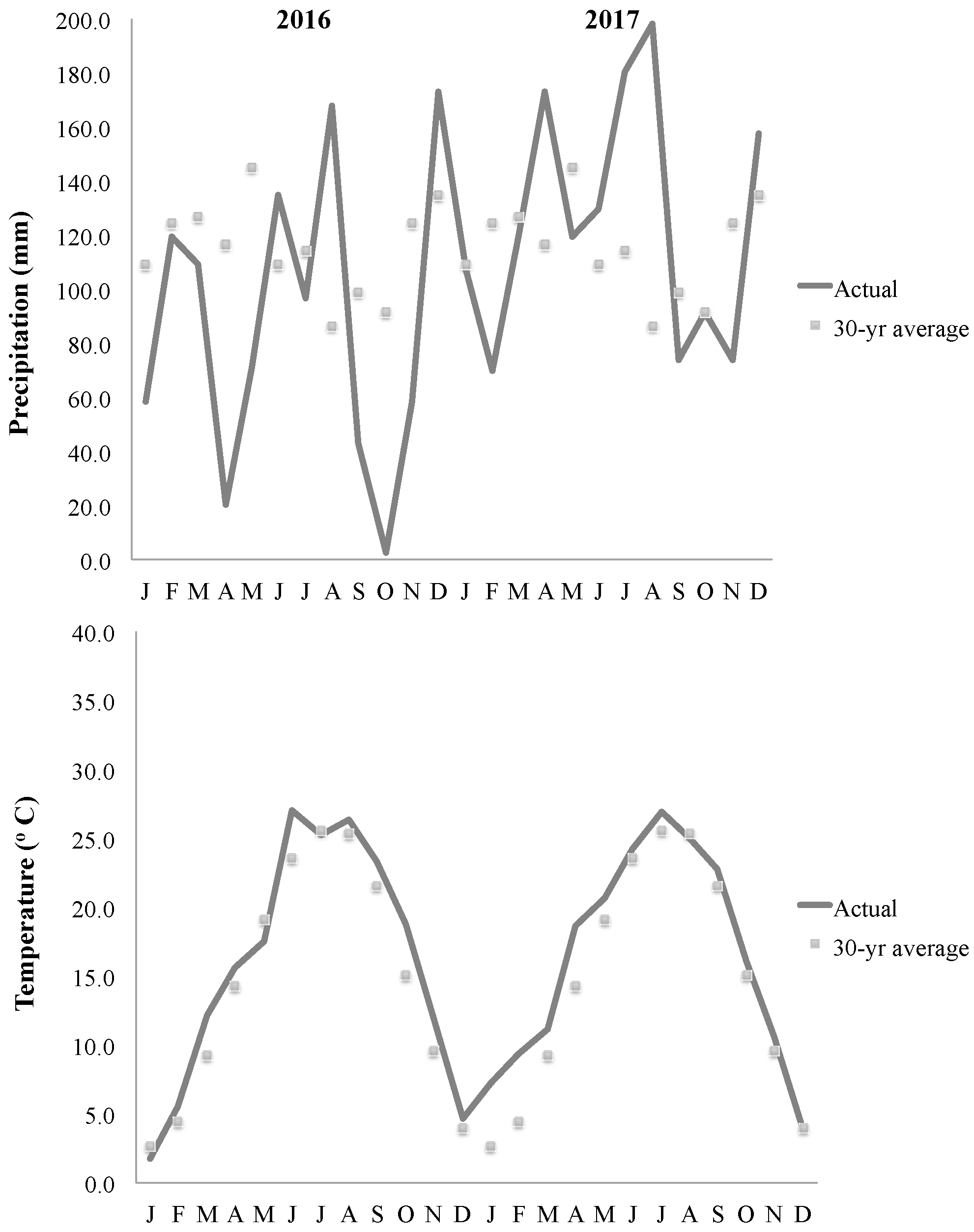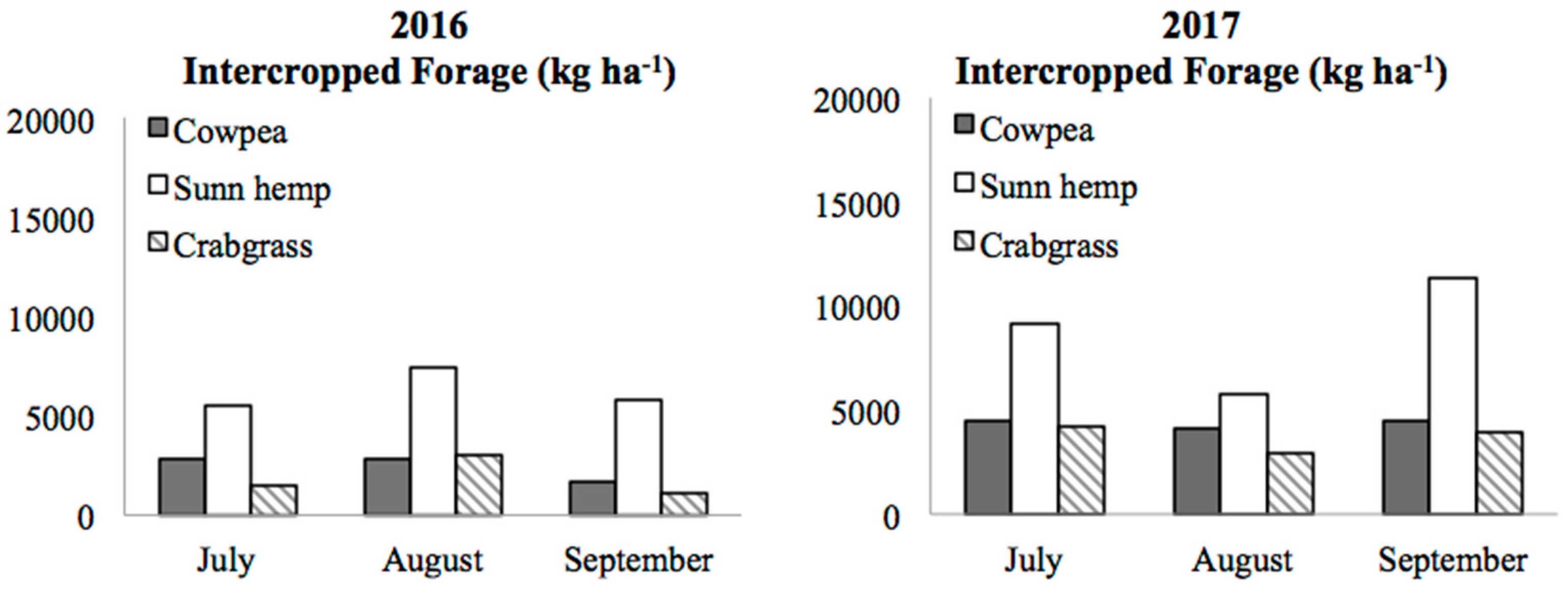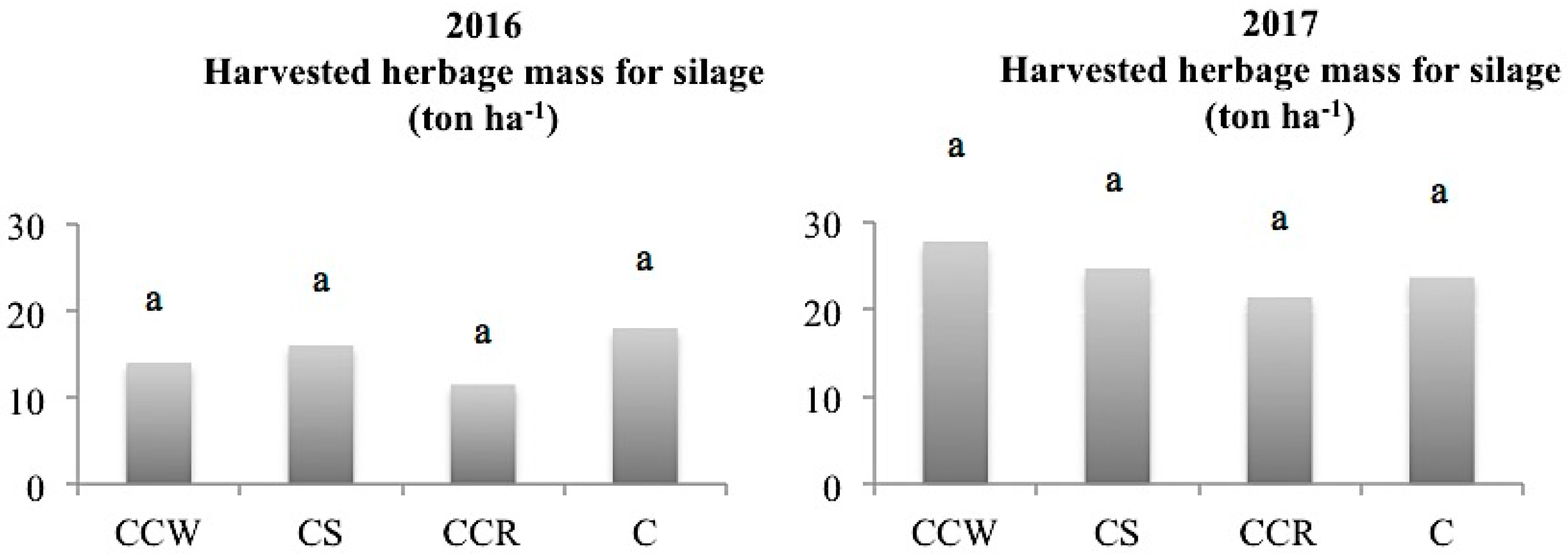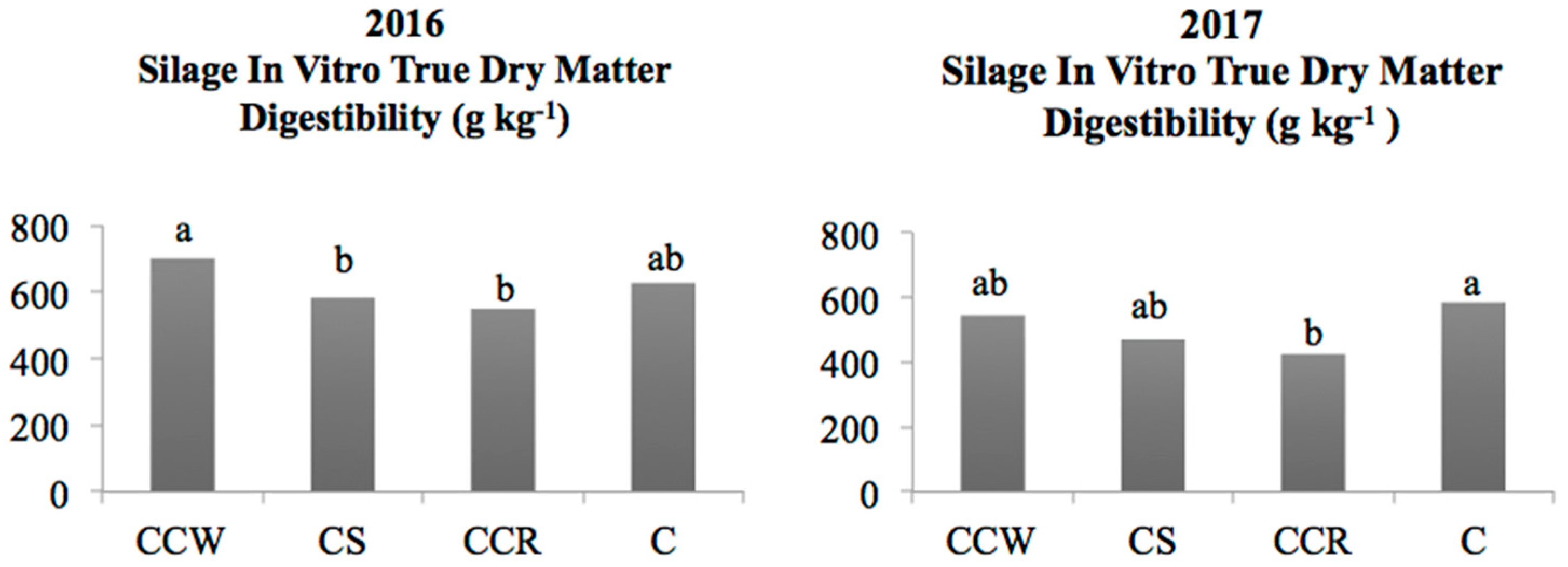Forage Warm-Season Legumes and Grasses Intercropped with Corn as an Alternative for Corn Silage Production
Abstract
:1. Introduction
2. Material and Methods
2.1. Site Description and Experimental Design
2.2. Measurements
2.3. Silage Composition
2.4. Statistical Analysis
3. Results and Discussion
3.1. Weather
3.2. Corn Characteristics
3.3. Forage Mass and Nutritive Value of Intercropped Forages
3.4. Harvested Herbage Mass for Silage Production and Silage In Vitro Dry Matter Digestibility
4. Conclusions
Author Contributions
Funding
Acknowledgments
Conflicts of Interest
References
- Hauggard-Nielsen, H.; Ambus, P.; Jensen, E.S. Interspecific competition, N use and interference with weeds in pea-barley intercropping. Field Crops Res. 2001, 70, 101–109. [Google Scholar] [CrossRef]
- Hardin, B. Intercropping for more forage and less erosion. Agric. Res. 1996, 44, 15–16. [Google Scholar]
- Contreras-Govea, F.E.; Lauriault, L.M.; Marsalis, M.; Angadi, S.; Puppala, N. Performance of forage sorghum-legume mixtures in southern High Plains, USA. Forage Grazinglands 2009, 7. [Google Scholar] [CrossRef]
- Allen, V.G.; Brown, C.P.; Kellison, R.; Segarra, E.; Wheeler, T.; Dotray, P.A.; Conkwright, J.C.; Green, C.J.; Acosta-Martinez, V. Integrating cotton and beef production to reduce water withdrawal from the Orgallala Aquifer in the Southern High Plains. Agron. J. 2005, 97, 556–567. [Google Scholar] [CrossRef]
- Kaspar, T.C.; Radke, J.K.; Laflen, J.M. Small grain cover crops and wheel traffic effects on infiltration, runoff and erosion. J. Soil Water Conserv. 2001, 56, 160–164. [Google Scholar]
- Ruffo, M.L.; Bullock, D.G.; Bollero, G.A. Soybean yield as affected by biomass and nitrogen uptake of cereal rye in winter cover crop rotations. Agron. J. 2004, 96, 800–805. [Google Scholar] [CrossRef]
- Sa, J.C.; Sulc, R.M.; Moraes, A. Carbon and nitrogen particle size fractions affected by winter grazing in Southern Brazil. In Proceedings of the ASA, CSSA, SSSA Annual Meetings, Madison, WI, USA, 21 July 2003. [Google Scholar]
- Fisk, J.W.; Hesterman, O.B.; Shrestha, A.; Kells, J.J.; Harwood, R.R.; Squire, J.M.; Sheaffer, C.C. Weed suppression by annual legume cover crops in no-tillage corn. Agron. J. 2001, 93, 319–325. [Google Scholar] [CrossRef]
- Entz, M.H.; Baron, V.S.; Carr, P.M.; Meyer, D.W.; Smith, S.R., Jr.; McCaughey, W.P. Potential of forages to diversify cropping systems in the Northern Great Plains. Agron. J. 2002, 94, 240–250. [Google Scholar] [CrossRef]
- Fae, G.S.; Sulc, R.M.; Barker, D.J.; Dick, R.P.; Eastridge, M.L.; Lorenz, N. Integrating winter annual forages into a no-till corn silage system. Agron. J. 2009, 101, 1286–1296. [Google Scholar] [CrossRef]
- Freitas, F.C.L.; Santos, M.V.; Machado, A.F.L.; Ferreira, L.R.; Freitas, M.A.M.; Silva, M.G.O. Behavior of corn cultivars intercropped with Brachiaria brizantha in the presence and absence of sprayed foramsulfuron + iodosulfuron-methyl. Planta Daninha 2008, 26, 215–221. [Google Scholar] [CrossRef]
- Silva, A.C.; Ferreira, L.R.; Silva, A.A.; Paiva, T.W.B.; Sediyama, C.S. Effects of reduced rates of fluazifop-P-butyl on soybean intercropped with Brachiaria brizantha. Planta Daninha 2004, 22, 429–435. [Google Scholar] [CrossRef]
- Barducci, R.S.; Costa, C.; Crusciol, C.A.C.; Borghi, E.; Putanov, T.C.; Sarti, L.M.N. Production of Brachiaria brizantha and Panicum maximum with corn and nitrogen fertilization. Arch. Zootecnia 2009, 58, 211–222. [Google Scholar]
- Contreras-Govea, F.E.; VanLeeuwen, D.M.; Angadi, S.V.; Marsalis, M.A. Enhances in crude protein and effects on fermentation profile of corn and forage sorghum silage with addition of cowpea. Forage Grazinglands 2013, 11. [Google Scholar] [CrossRef]
- Hanlon, E.A.; Savoy, H.J. Procedures Used by State Soil Testing Laboratories in Southern Region of the United States; Southern Cooperative Series Bulletin; Clemson Experiment Station: Clemson, SC, USA, 2007; Volume D, p. 190. [Google Scholar]
- Murray, I.; Cowe, I. Sample preparation. In Near Infrared Spectroscopy in Agriculture; Roberts, C.A., Workman, J., Jr., Reeves, J.B., III, Eds.; ASA: Madison, WI, USA, 2004; pp. 75–115. [Google Scholar]
- Borghi, E.; Crusciol, C.A.C. Corn yield, spacing and intercropping modalities with Brachiaria brizantha in no-tillage system. Pesquisa Agropecuária Brasileira 2007, 42, 163–171. [Google Scholar] [CrossRef]
- Neely, C.B.; Rouquette, F.M., Jr.; Morgan, C.L.; Smith, G.R.; Hons, F.M.; Rooney, W.L. Integrating legumes as cover crops and intercrops into grain sorghum production systems. Agron. J. 2018, 110, 1363–1378. [Google Scholar] [CrossRef]
- Balkcom, K.S.; Reeves, D.W. Sunn-hemp utilized as a legume cover crop for corn production. Agron. J. 2004, 97, 26–31. [Google Scholar] [CrossRef]
- Gelley, C.; Nave, R.L.G.; Bates, G. Forage nutritive value and herbage mass relationship of four warm-season grasses. Agron. J. 2016, 108, 1603–1613. [Google Scholar] [CrossRef]
- Teutsch, C.D.; Fike, J.H.; Wilson, W.M. Yield, digestibility, and nutritive value of crabgrass as impacted by nitrogen fertilization rate and source. Agron. J. 2005, 97, 1640–1646. [Google Scholar] [CrossRef]
- Schomberg, H.H.; Martini, N.L.; Diaz-Perez, J.C.; Phatak, S.C.; Balkcom, K.S.; Bhardwaj, H.L. Potential for using sunn hemp as a source of biomass and nitrogen for the Piedmont and Coastal Plain regions of the Southeastern USA. Agron. J. 2006, 99, 1448–1457. [Google Scholar] [CrossRef]
- Crusciol, C.A.C.; Nascente, A.S.; Mateus, G.P.; Borghi, E.; Leles, E.P.; Santos, N.C.B. Effect of intercropping on yields of corn with different relative maturities and palisadegrass. Agron. J. 2013, 105, 599–606. [Google Scholar] [CrossRef]
- Sawyer, J.E.; Pedersen, P.; Barker, D.W.; Diaz, D.A.R.; Albrecht, L. Intercropping corn and kura clover: Response to nitrogen fertilization. Agron. J. 2010, 102, 568–574. [Google Scholar] [CrossRef]
- Pariz, C.M.; Costa, C.; Crusciol, C.A.C.; Meirelles, P.R.L.; Castilhos, A.M.; Andreotti, M.; Costa, N.R.; Martello, J.M.; Souza, D.M.; Sarto, J.R.W. Production and soil responses to intercropping of forage grasses with corn and soybean silage. Agron. J. 2016, 108, 2541–2553. [Google Scholar] [CrossRef]
- Armstrong, K.L.; Albrecht, K.A. Effect of plant density on forage yield and quality of intercropped corn and lablab bean. Crop Sci. 2007, 48, 814–822. [Google Scholar] [CrossRef]
- Contreras-Govea, F.E.; Marsalis, M.A.; Angadi, S.V.; Smith, G.; Laurialt, M.; VanLeeuwen, D.M. Fermentability aqnd nutritive value of corn and forage sorghum silage when mixed with lablab bean. Crop Sci. 2010, 51, 1307–1313. [Google Scholar] [CrossRef]




| Plant Population (No. ×1000) | Ear Height (cm) | Plant Height (cm) | ||||||||
|---|---|---|---|---|---|---|---|---|---|---|
| July | August | September | July | August | September | July | August | September | ||
| 2016 | CCW | 95 a | 97 a | 96 a | 55 a | 87 a | 85 a | 185 b | 218 a | 211 a |
| CS | 51 b | 51 b | 50 b | 0 b | 49 b | 0 b | 145 c | 157 b | 158 b | |
| CCR | 83 a | 82 a | 82 a | 82 a | 85 a | 88 a | 204 ab | 249 a | 245 a | |
| C | 85 a | 82 a | 82 a | 87 a | 83 ab | 86 a | 234 a | 251 a | 238 a | |
| C | ||||||||||
| 2017 | CCW | 63 a | 58 a | 78 a | 80 a | 238 a | 251 a | 241 a | ||
| CS | 55 a | 46 a | 80 a | 82 a | 240 a | 245 a | 228 a | |||
| CCR | 56 a | 54 a | 66 ab | 74 a | 235 a | 243 a | 234 a | |||
| C | 41 a | 41 a | 45 b | 75 a | 232 a | 237 a | 234 a | |||
| CP (g kg−1) | NDF (g kg−1) | IVTDMD (g kg−1) | ||||||||
|---|---|---|---|---|---|---|---|---|---|---|
| July | August | September | July | August | September | July | August | September | ||
| 2016 | Cowpea | . | 205 a | 159 a | . | 438 b | 467 b | . | 811 a | 766 a |
| Sunn hemp | . | 177 b | 113 b | . | 524 ab | 615 a | . | 718 b | 608 b | |
| Crabgrass | . | 165 b | 110 b | . | 561 a | 643 a | . | 743 ab | 673 b | |
| C | ||||||||||
| 2017 | Cowpea | 195 a | 192 a | 218 a | 305 b | 324 b | 319 c | 937 a | 916 a | 884 a |
| Sunn hemp | 172 a | 120 b | 123 b | 390 b | 519 ab | 505 b | 874 a | 729 b | 728 b | |
| Crabgrass | 147 a | 97 b | 67 b | 572 a | 634 a | 724 a | 768 b | 707 b | 617 c | |
© 2018 by the authors. Licensee MDPI, Basel, Switzerland. This article is an open access article distributed under the terms and conditions of the Creative Commons Attribution (CC BY) license (http://creativecommons.org/licenses/by/4.0/).
Share and Cite
La Guardia Nave, R.; Corbin, M.D. Forage Warm-Season Legumes and Grasses Intercropped with Corn as an Alternative for Corn Silage Production. Agronomy 2018, 8, 199. https://doi.org/10.3390/agronomy8100199
La Guardia Nave R, Corbin MD. Forage Warm-Season Legumes and Grasses Intercropped with Corn as an Alternative for Corn Silage Production. Agronomy. 2018; 8(10):199. https://doi.org/10.3390/agronomy8100199
Chicago/Turabian StyleLa Guardia Nave, Renata, and Michael Dereck Corbin. 2018. "Forage Warm-Season Legumes and Grasses Intercropped with Corn as an Alternative for Corn Silage Production" Agronomy 8, no. 10: 199. https://doi.org/10.3390/agronomy8100199
APA StyleLa Guardia Nave, R., & Corbin, M. D. (2018). Forage Warm-Season Legumes and Grasses Intercropped with Corn as an Alternative for Corn Silage Production. Agronomy, 8(10), 199. https://doi.org/10.3390/agronomy8100199




